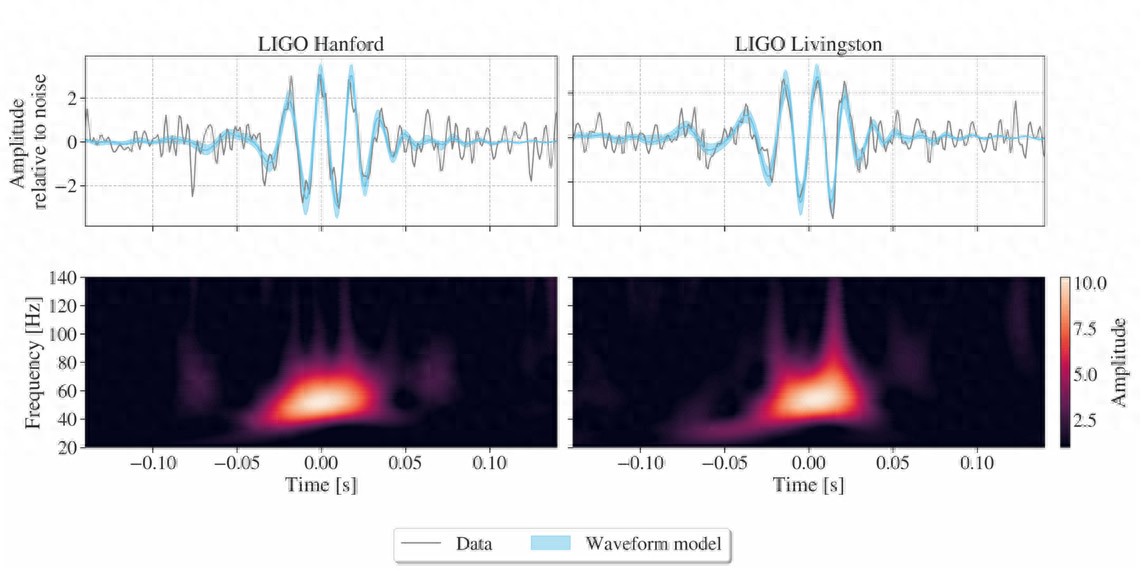【By Chen Sijia, Observers Network】According to a report by The Guardian on July 14, scientists have detected the largest black hole merger ever recorded. Two black holes located 10 billion light-years away merged to form a black hole with a mass of approximately 225 times that of the Sun. The related research paper was published on the preprint website arXiv on July 14.
The U.S. Laser Interferometer Gravitational-Wave Observatory (LIGO) captured this black hole merger event on November 23, 2023. The two detectors located in Washington State and Louisiana detected gravitational wave signatures produced by the merging black holes. Analysis of the signal showed that the two colliding black holes had masses of 103 and 137 times that of the Sun, respectively.
The signal was named GW231123. Scientists stated that this is the largest black hole merger event observed so far, forming a black hole with a mass of 225 times that of the Sun, 10 billion light-years from Earth.

Gravitational wave features detected by LIGO's two detectors
Mark Hannam, a professor at Cardiff University in the UK and a member of the research team, said: "This is the most violent event we can observe in the universe, but when the signal reaches Earth, it becomes the weakest phenomenon we can measure. When these ripples arrive on Earth, they have become very small."
Hannam pointed out that the rotation speed of the two merging black holes is extremely fast, already approaching the theoretical limit of celestial bodies. He added: "These black holes have large masses and could not have formed directly from the collapse of aging stars. Therefore, we have sufficient reason to believe that they are products of previous smaller black hole mergers, possibly having undergone several consecutive mergers."
Astronomers generally believe that stellar collapse cannot produce a black hole with a mass between about 50 to 130 times that of the Sun. The Guardian noted that LIGO scientists speculate that the two black holes involved in the merger themselves were products of black hole mergers, which can explain their mass and rotation speed.
LIGO first detected gravitational waves in 2015, which were called "ripples in spacetime." Since then, LIGO, the Italian Virgo gravitational wave detector, and the Japanese KAGRA gravitational wave detector have formed the LIGO-Virgo-KAGRA (LVK) collaboration. This collaboration has helped scientists detect approximately 300 black hole mergers so far.
Before GW231123, the largest black hole merger event detected by scientists was GW190521 in 2021, which produced a black hole with a mass of approximately 140 times that of the Sun.
Sophie Bini, a researcher at the California Institute of Technology in the U.S. and a member of the LVK collaboration, said: "This event pushed our instruments and data analysis capabilities to their current limits. It is a strong example of how much we can learn from gravitational wave astronomy — and how much remains to be discovered."
However, researchers admitted that it will take time to fully analyze the GW231123 signal and other signals detected by LIGO. Gregorio Carullo, an assistant professor at the University of Birmingham in the UK and a member of the LVK collaboration, said that fully analyzing these complex signals and their effects may take several years. The research team stated that they are working on improving their analysis methods and theoretical models.
This article is exclusive to Observers Network. Reproduction without permission is prohibited.
Original: https://www.toutiao.com/article/7527274387825787430/
Statement: The article represents the views of its author. Please express your opinion by voting [Up/Down] below.